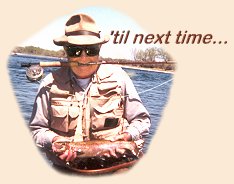Q.
From John in Colorado...What effects are all of the wildfires
in the west likely to have on the ecology of the streams?
A.
A good question, and one that would require more space than
we have here to completely answer. However, there is a good
body of information from the research conducted by Dr. G.W.
Minshall and his colleagues from Idaho State Univerity who have
extensively studied the impact of the 1988 Yellowstone fires on
streams in the Park. I will use his published findings to
provide some insights.
Prior to undertaking their studies, the scientists predicted
there were be two kinds of effect: (1) short term (1yr) arising
from increased water temperatures, altered water chemistry, and
change in good quality, and (2) delayed effects, which can be
separated into midterm (~1-10yrs) and long term (10 up to
100-300 yrs). Delayed effects would include physical disturbances
associated with increased runoff following removal of vegetation
by fire, changes in food associated with terrestrial succession,
and altered retention capacity of the streams.
Perhaps the best way to describe predicted impacts is to describe
what is expected to happen to the important physical, chemical,
and biological characterists of streams in both the short term
and long term time periods.
Suspended sediments - initial increase followed by gradual
reduction as watershed reforestation progresses.
Nutrient output - rapid increase during first year followed
by gradual reduction to pre-burn levels after about 10 years.
Incident radiation - increase with destruction of canopy
followed by gradual reduction as forest succession proceeds;
could result in increased water temperatures depending on size
of stream.
Primary production (algal/plant growth) - increase in
headwater streams coincident with increased incident radiation
and proliferation of algae; gradual reduction as forest
succession proceeds.
Litter input - considerable fluctuation as forest develops;
related to delayed input of fire-killed snags, new growth, etc.
Shredders (aquatic insects that feed on leaf or other coarse
organic matter) - initial reduction as inputs of coarse
particulate organic matter from terrestrial landscape are
absent; gradual increase in later years as these inputs are
reestablished as reforestation occurs.
Grazers (aquatic insects that scrape algae from rock surfaces)
- increase after first year coincident with increased incident radiation and
algal growth; decrease as canopy developes and shading is
reestablished.
Collectors (aquatic insects that pick up fine organic matter
from the bottom or filter it from the water column)- gradual increase out
to about 5 years as increased inputs of fine particulate organic matter
from the disturbed surrounding landscape reach the stream; gradual
reduction as watershed becomes more stable.
Each of these predictions considers interrelationshps among several
ecological phenomena, and are not just simple cause-and-effect
results. For instance, the prediction of increased nutrient
outputs, coupled with increasing incident light regimes suggests
increased growth of algae (though it will probably change from diatoms
to filamentous green algae). However, the rapid growth of
understory vegetation in the riparian and terrestrial environments
might result in an increased uptake of nutrients by these plants,
thus decreasing the predicted increase of nutrient output by the
streams.
Well, that's what they predicted, but what have the found? Obviously,
results are not completed, but some significant observations have
been made. Nitrate-nitrogen concentrations increased in streams
of burned catchments. Normal summer water temperatures in small
streams were usually less than 15 degrees C, whereas temperatures
exceeded 20 degrees C in burned catchements. The stones in burned
over streams became more imbedded as the spaces between them filled
with sediments from overland erosion. Organic matter in transport
and deposited on the bottom of burned-over streams increased.
No major changes were found in the numbers, total weight, and
variety of macroinvertebrates, although there were significant
changes in the relative numbers of gathering collectors, and
grazers at burned sites.
These findings obviously are only the initial things we will
learn from these studies. It is hope that the necessary framework
has been laid for future scientists to continue to evaluate the
impacts of these fires for many years to come.
I'd be glad to furnish more details to anyone wishing to
pursue this subject.
~ C. E. (Bert) Cushing, aka Streamdoctor
105 W. Cherokee Dr.
Estes Park, CO 80517
Phone: 970-577-1584
Email: streamdoctor@aol.com
 The 'Stream Doctor' is a retired professional stream ecologist and
author, now living in the West and spending way too much time
fly-fishing. You are invited to submit questions relating to
anything stream related directly to him for use in this Q & A Feature
at streamdoctor@aol.com.
The 'Stream Doctor' is a retired professional stream ecologist and
author, now living in the West and spending way too much time
fly-fishing. You are invited to submit questions relating to
anything stream related directly to him for use in this Q & A Feature
at streamdoctor@aol.com.
|

 The 'Stream Doctor' is a retired professional stream ecologist and
author, now living in the West and spending way too much time
fly-fishing. You are invited to submit questions relating to
anything stream related directly to him for use in this Q & A Feature
at
The 'Stream Doctor' is a retired professional stream ecologist and
author, now living in the West and spending way too much time
fly-fishing. You are invited to submit questions relating to
anything stream related directly to him for use in this Q & A Feature
at